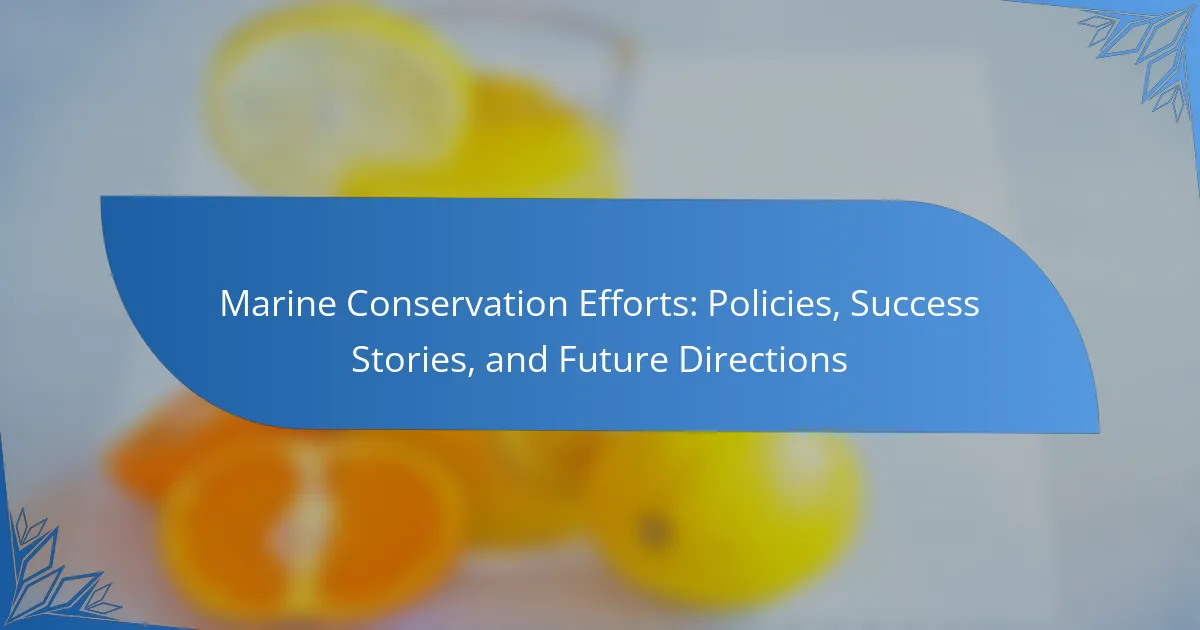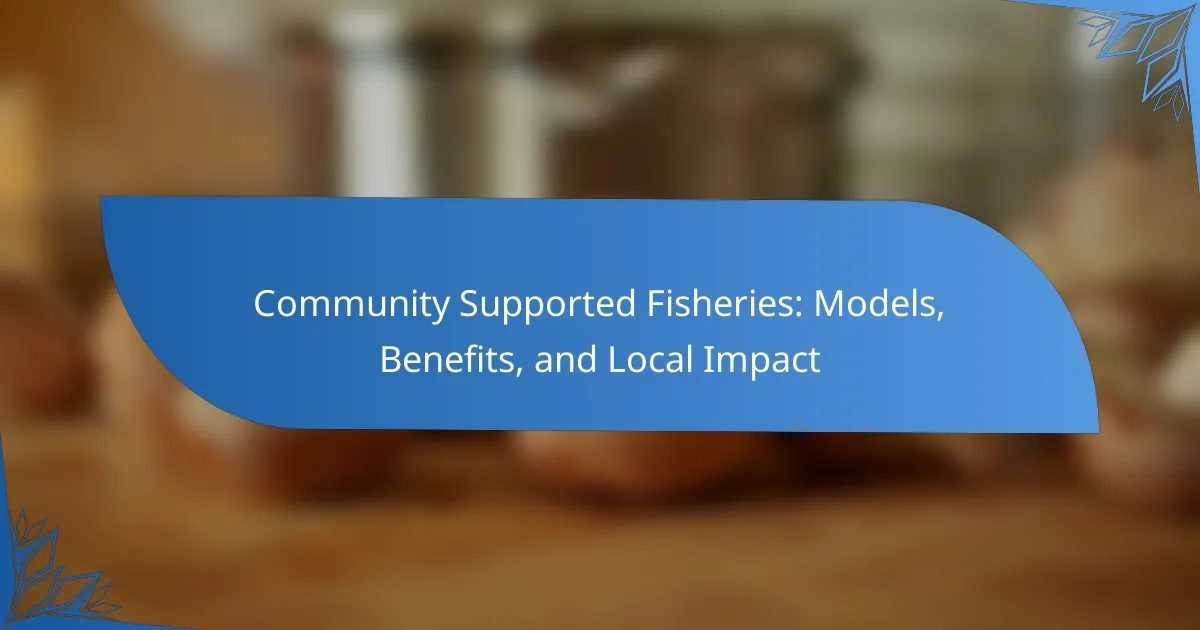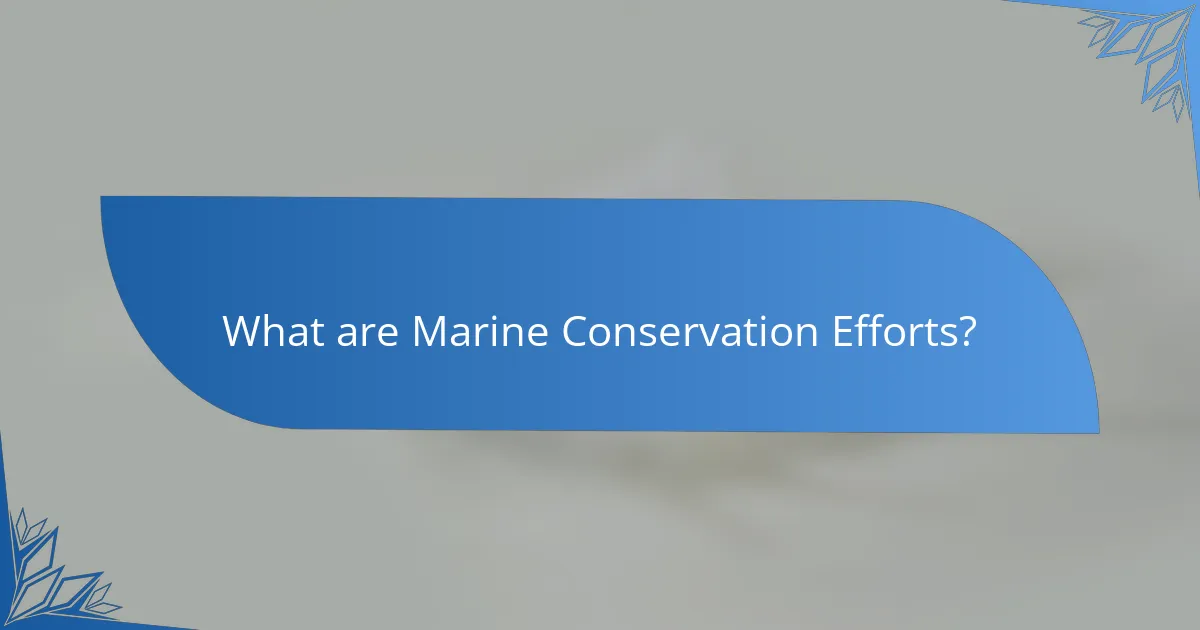
What are Marine Conservation Efforts?
Marine conservation efforts are initiatives aimed at protecting and restoring marine ecosystems. These efforts include establishing marine protected areas, regulating fishing practices, and reducing pollution in oceans. They also involve habitat restoration projects, such as coral reef rehabilitation. According to the United Nations, over 7% of the world’s oceans are currently designated as protected areas. Marine conservation is critical for maintaining biodiversity and ensuring sustainable use of ocean resources. Studies show that effective conservation can lead to healthier fish populations and improved ecosystem resilience.
Why are Marine Conservation Efforts important?
Marine conservation efforts are important because they protect biodiversity and sustain marine ecosystems. Healthy marine environments support fishing industries and tourism, contributing to local economies. Additionally, these efforts help combat climate change by preserving carbon-absorbing habitats like mangroves and coral reefs. Studies show that marine protected areas can increase fish populations by up to 600%. Effective conservation strategies also safeguard endangered species from extinction. The ocean provides essential resources, including oxygen and food, making its conservation critical for human survival.
What threats do marine ecosystems face?
Marine ecosystems face numerous threats, including climate change, overfishing, pollution, and habitat destruction. Climate change leads to ocean warming and acidification, which disrupts marine life. Overfishing depletes fish stocks and alters the balance of marine ecosystems. Pollution from plastics and chemicals contaminates water and harms marine organisms. Habitat destruction occurs through coastal development and destructive fishing practices, resulting in loss of biodiversity. According to the United Nations, about 30% of the world’s fish stocks are overfished, highlighting the urgency of addressing these threats.
How do conservation efforts address these threats?
Conservation efforts address threats to marine ecosystems through various strategies. These include the establishment of marine protected areas (MPAs). MPAs restrict human activities that harm marine life. They promote biodiversity and help ecosystems recover. Additionally, conservation initiatives focus on sustainable fishing practices. These practices reduce overfishing and protect vulnerable species. Education and community engagement are also vital components. They raise awareness about marine conservation and encourage local stewardship. Scientific research supports these efforts by providing data on ecosystem health. For example, studies show that MPAs can lead to increased fish populations and improved habitat quality. Overall, these combined approaches are essential for mitigating threats to marine environments.
What types of Marine Conservation Policies exist?
Marine conservation policies include various frameworks aimed at protecting marine ecosystems. Key types are Marine Protected Areas (MPAs), which restrict human activities to conserve biodiversity. Fisheries management policies regulate fishing practices to prevent overfishing and ensure sustainable fish populations. Coastal zone management policies address the development and conservation of coastal areas, balancing ecological health with human use. International treaties, such as the Convention on Biological Diversity, facilitate global cooperation on marine conservation. Each of these policies plays a vital role in preserving marine environments and resources.
How do international agreements impact marine conservation?
International agreements significantly enhance marine conservation by establishing collaborative frameworks among nations. These agreements provide guidelines for sustainable fishing practices and habitat protection. For instance, the Convention on Biological Diversity promotes the protection of marine biodiversity. The United Nations Convention on the Law of the Sea outlines maritime rights and responsibilities. Such frameworks facilitate coordinated efforts to address issues like overfishing and pollution. They also encourage the sharing of scientific research and best practices. Data from the Global Ocean Commission shows that effective international cooperation can lead to improved marine ecosystem health. Overall, these agreements are crucial for fostering global responsibility towards ocean conservation.
What role do national policies play in marine conservation?
National policies are crucial in marine conservation as they establish legal frameworks and guidelines for protecting marine ecosystems. These policies regulate activities such as fishing, shipping, and coastal development. They also designate marine protected areas (MPAs) that limit human activities to preserve biodiversity. Effective national policies promote sustainable practices and encourage research in marine science. Countries with strong marine policies, like Australia and the United States, have seen improvements in marine health. According to the World Resources Institute, well-implemented policies can lead to a 30% increase in fish populations within MPAs. Thus, national policies are essential for the long-term sustainability of marine environments.
What are some successful Marine Conservation initiatives?
Successful marine conservation initiatives include the establishment of marine protected areas (MPAs), which cover approximately 7.6% of the world’s oceans. The Great Barrier Reef Marine Park in Australia is a prominent example, showcasing biodiversity protection and sustainable tourism. The Ocean Cleanup project aims to remove plastic from the Great Pacific Garbage Patch, targeting the removal of 90% of ocean plastic by 2040. The Coral Triangle Initiative involves six countries working together to conserve marine resources and promote sustainable fisheries. Additionally, the “30 by 30” initiative seeks to protect 30% of the world’s oceans by 2030, gaining support from various nations. These initiatives demonstrate effective strategies for marine conservation and highlight the importance of international collaboration.
What case studies highlight effective marine conservation efforts?
The case studies that highlight effective marine conservation efforts include the Great Barrier Reef Marine Park in Australia, the Galápagos Marine Reserve in Ecuador, and the coastal management initiatives in Belize. The Great Barrier Reef Marine Park has implemented zoning regulations that protect biodiversity and promote sustainable tourism. Research shows that these regulations have led to an increase in fish populations and coral health. The Galápagos Marine Reserve has successfully reduced illegal fishing through strict enforcement and community engagement. Studies indicate that this approach has helped preserve unique marine species. Belize’s coastal management initiatives focus on protecting mangroves and coral reefs. Evidence shows that these efforts have improved coastal resilience and enhanced local fisheries. Each of these case studies demonstrates effective strategies and measurable outcomes in marine conservation.
How have local communities contributed to conservation success?
Local communities have significantly contributed to conservation success through active participation and stewardship. They engage in sustainable fishing practices that protect marine ecosystems. Community-led initiatives often result in effective management of local resources. For instance, the establishment of marine protected areas (MPAs) is frequently driven by local input. Research shows that MPAs co-managed by communities have higher biodiversity levels. Local knowledge enhances conservation strategies, making them more adaptive and relevant. Community involvement fosters a sense of ownership, leading to better compliance with conservation regulations. Successful examples include the involvement of indigenous groups in the Great Barrier Reef management. These contributions demonstrate the vital role of local communities in achieving conservation goals.
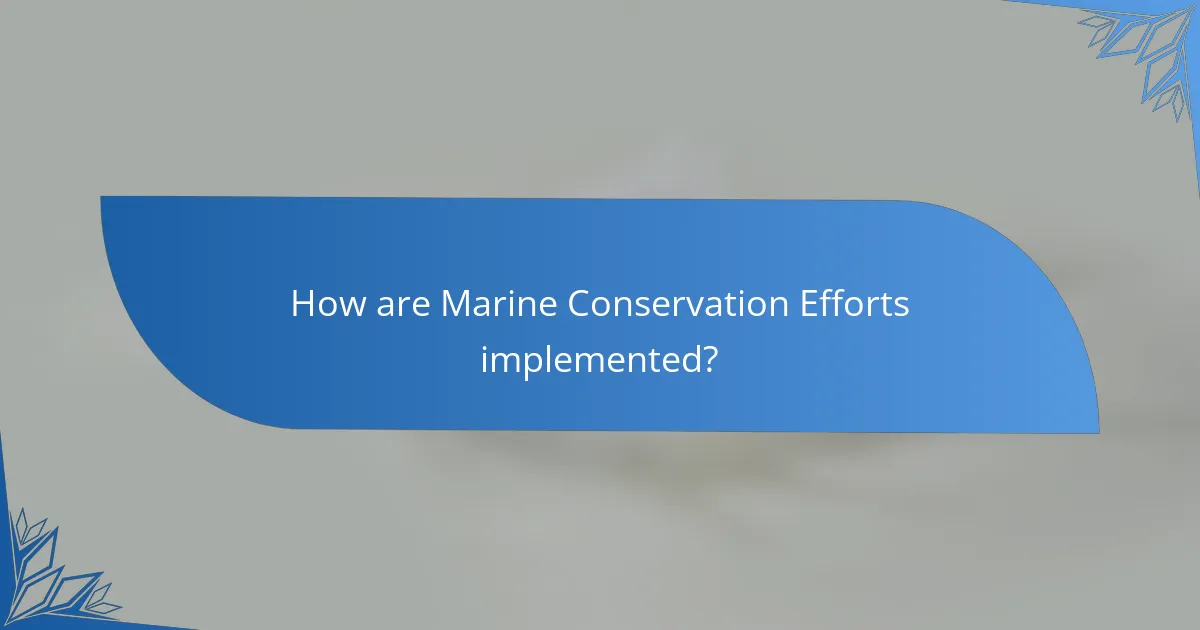
How are Marine Conservation Efforts implemented?
Marine conservation efforts are implemented through various strategies and policies aimed at protecting marine ecosystems. These strategies include establishing marine protected areas (MPAs) to restrict human activities. MPAs can help restore biodiversity and protect endangered species. Legislation is also crucial, as laws regulate fishing practices and pollution controls. Community engagement plays a significant role in conservation success. Local stakeholders are often involved in decision-making processes. Education and awareness campaigns inform the public about marine issues. Scientific research supports conservation efforts by providing data on ecosystem health. Collaborative initiatives among governments, NGOs, and local communities enhance the effectiveness of marine conservation.
What strategies are used in marine conservation?
Marine conservation strategies include the establishment of marine protected areas (MPAs), sustainable fishing practices, and habitat restoration efforts. MPAs restrict human activities to protect marine biodiversity. Research shows that MPAs can lead to increased fish populations and healthier ecosystems. Sustainable fishing practices aim to reduce bycatch and overfishing. These practices help maintain fish stocks and support local economies. Habitat restoration involves rehabilitating damaged ecosystems, such as coral reefs and mangroves. Studies indicate that restored habitats can recover biodiversity and improve resilience to climate change. Community involvement and education are also crucial strategies. Engaging local communities fosters stewardship and ensures the sustainability of conservation efforts.
How does habitat restoration contribute to marine conservation?
Habitat restoration significantly contributes to marine conservation by rehabilitating ecosystems that support marine life. Restoring habitats like coral reefs and mangroves enhances biodiversity. Healthy ecosystems provide essential services, such as carbon sequestration and coastal protection. Restoration efforts can lead to increased fish populations, benefiting local fisheries. According to a study published in Marine Ecology Progress Series, restored coral reefs can recover fish biomass by up to 50% within five years. Additionally, restored mangrove forests can improve water quality and serve as nurseries for juvenile marine species. These benefits highlight the critical role of habitat restoration in sustaining marine ecosystems and promoting biodiversity.
What is the role of marine protected areas (MPAs)?
Marine protected areas (MPAs) play a crucial role in conserving marine biodiversity. They provide safe habitats for various marine species, allowing ecosystems to thrive. MPAs help replenish fish stocks by restricting fishing activities in designated zones. According to the International Union for Conservation of Nature, well-managed MPAs can lead to a 20-100% increase in fish biomass. These areas also protect critical habitats, such as coral reefs and mangroves, which are essential for numerous marine organisms. Additionally, MPAs contribute to climate change resilience by safeguarding ecosystems that sequester carbon. Overall, MPAs are vital tools for sustainable marine resource management and conservation efforts.
How do stakeholders collaborate in marine conservation?
Stakeholders collaborate in marine conservation through partnerships, shared goals, and coordinated actions. These stakeholders include governments, NGOs, local communities, and scientists. They work together to develop policies that protect marine ecosystems. Collaborative efforts often involve joint research initiatives to gather data on marine health. Stakeholders also engage in community outreach to raise awareness about conservation issues. Regular meetings and workshops facilitate communication among different parties. For example, the Coral Triangle Initiative brings together six countries to address marine biodiversity. This collaboration has led to the establishment of marine protected areas, showcasing its effectiveness.
What roles do government agencies play in marine conservation?
Government agencies play a critical role in marine conservation. They establish and enforce regulations to protect marine ecosystems. Agencies conduct scientific research to inform conservation strategies. They also allocate funding for marine conservation projects. Collaboration with non-governmental organizations enhances conservation efforts. Agencies develop policies to manage fisheries sustainably. They create marine protected areas to safeguard biodiversity. Public education campaigns raise awareness about marine conservation issues.
How do NGOs and community organizations contribute?
NGOs and community organizations contribute significantly to marine conservation efforts. They engage in advocacy for sustainable policies. These organizations often conduct research to inform conservation strategies. They also implement on-the-ground projects to restore marine ecosystems. For example, organizations like Oceana work to protect marine biodiversity through policy changes. Community groups often mobilize local populations for clean-up initiatives. These actions lead to improved water quality and habitat restoration. Their efforts raise awareness about marine issues and promote community involvement.
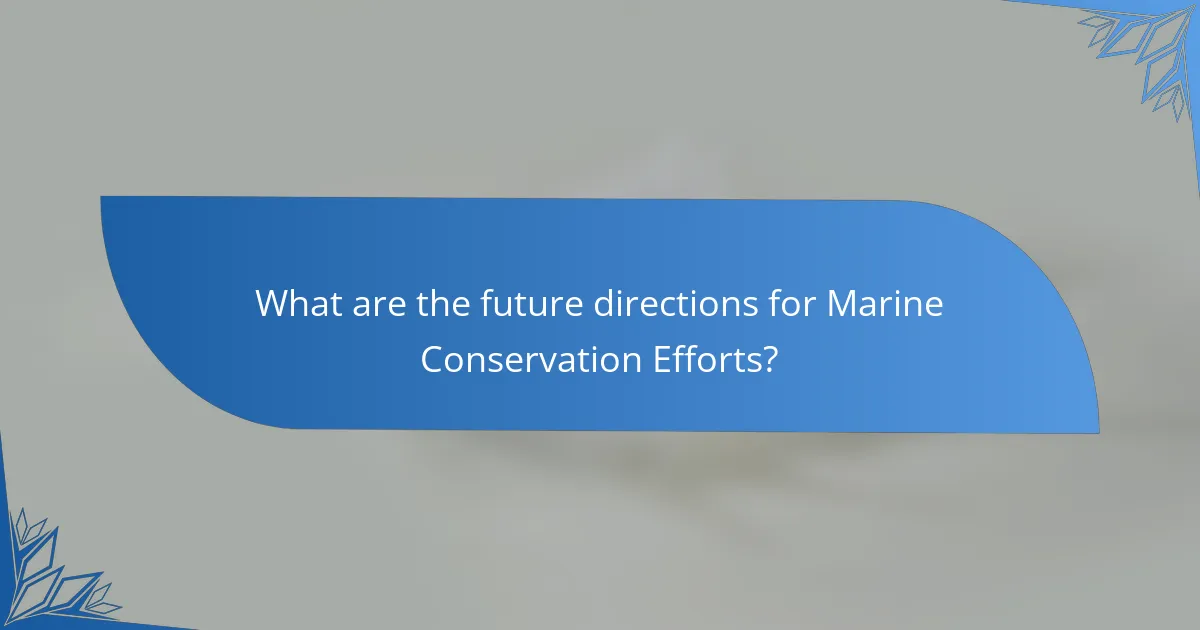
What are the future directions for Marine Conservation Efforts?
Future directions for marine conservation efforts include increased integration of technology, such as satellite monitoring and AI analytics. These technologies enhance data collection and monitoring of marine ecosystems. Collaborative governance models are also emerging, promoting partnerships between governments, NGOs, and local communities. This collaborative approach ensures diverse stakeholder involvement in decision-making.
Additionally, there is a growing focus on restoring marine habitats, such as coral reefs and mangroves, which are vital for biodiversity. Marine Protected Areas (MPAs) are expected to expand, aiming to cover 30% of the oceans by 2030. Climate change mitigation strategies will be crucial, as rising temperatures and ocean acidification threaten marine life.
Lastly, public awareness and education initiatives are increasing, fostering a conservation-minded society. These efforts aim to engage individuals in sustainable practices that benefit marine ecosystems.
How is technology shaping the future of marine conservation?
Technology is significantly shaping the future of marine conservation through innovative tools and methods. Remote sensing technologies allow for the monitoring of marine ecosystems from space. These tools can track changes in ocean temperature and pollution levels. Artificial intelligence aids in analyzing large datasets for better decision-making. Drones are being used for surveying marine habitats and tracking wildlife movements. Underwater robots collect data on marine species and their environments. Blockchain technology enhances transparency in seafood supply chains, combating illegal fishing. Mobile applications engage the public in reporting marine wildlife sightings. These advancements are crucial for effective conservation strategies and policy-making.
What innovations are being used to monitor marine ecosystems?
Innovations used to monitor marine ecosystems include remote sensing technology, underwater drones, and acoustic monitoring systems. Remote sensing employs satellite imagery to gather data on ocean temperature, chlorophyll levels, and sea surface height. This technology allows scientists to track changes in marine environments over large areas. Underwater drones, or autonomous underwater vehicles (AUVs), collect data on marine life and habitat conditions. They provide high-resolution images and can operate in challenging underwater environments. Acoustic monitoring systems use sound to track marine animals and assess biodiversity. These systems can detect and analyze vocalizations from various species, providing insights into their populations and behaviors. Together, these innovations enhance our understanding of marine ecosystems and inform conservation efforts.
How can data analytics improve conservation strategies?
Data analytics can significantly enhance conservation strategies by enabling data-driven decision-making. It allows for the analysis of large datasets related to species populations, habitat conditions, and human impacts. This analysis can identify trends and patterns that inform conservation priorities. For example, satellite data can track changes in marine ecosystems over time. Predictive modeling can forecast the impacts of climate change on specific species. Moreover, data analytics can optimize resource allocation for conservation efforts. It can also facilitate community engagement by visualizing data in accessible formats. These applications demonstrate that data analytics is crucial for effective conservation strategies.
What challenges lie ahead for Marine Conservation Efforts?
Marine conservation efforts face significant challenges ahead. Climate change is altering ocean temperatures and affecting marine ecosystems. Overfishing continues to deplete fish populations and disrupt food chains. Pollution from plastics and chemicals is harming marine life and habitats. Habitat destruction, such as coral reef degradation, threatens biodiversity. Inadequate funding limits the effectiveness of conservation programs. Political and economic interests often conflict with conservation goals. Public awareness and engagement remain low in many regions. These challenges require coordinated global action and innovative solutions to ensure the future of marine ecosystems.
How does climate change impact future conservation efforts?
Climate change significantly impacts future conservation efforts by altering ecosystems and species distributions. Rising temperatures affect marine habitats, leading to coral bleaching and loss of biodiversity. Ocean acidification, a consequence of increased CO2 levels, threatens shellfish and other marine organisms. These changes disrupt food webs and impact fisheries, which are vital for human livelihoods. Conservation strategies must adapt to these shifting conditions to remain effective. For instance, protected areas may need to be relocated to ensure they encompass critical habitats. Additionally, climate change necessitates integrating climate resilience into conservation planning. The Intergovernmental Panel on Climate Change (IPCC) reports that without significant mitigation efforts, the effectiveness of current conservation initiatives will be severely compromised.
What are the potential economic impacts of marine conservation policies?
Marine conservation policies can lead to both positive and negative economic impacts. Positive impacts include increased tourism revenue due to healthier marine ecosystems. For example, protected areas often attract divers and eco-tourists, boosting local economies. A study by the World Resources Institute found that marine protected areas can increase fish populations, enhancing local fisheries. This can result in higher catches and income for fishermen.
On the negative side, some policies may restrict fishing and other economic activities, affecting livelihoods. For instance, regulations that limit fishing zones can lead to reduced income for commercial fishers. A report from the Food and Agriculture Organization highlights that these restrictions can create short-term economic challenges for coastal communities.
Overall, the economic impacts of marine conservation policies vary widely depending on implementation and local contexts.
What can individuals do to support Marine Conservation Efforts?
Individuals can support marine conservation efforts by reducing plastic use. This action helps decrease ocean pollution, which affects marine life. Engaging in beach clean-ups is another effective way to contribute. Studies show that organized clean-ups can remove tons of waste from coastal areas each year. Supporting sustainable seafood choices also aids marine ecosystems. The Marine Stewardship Council reports that sustainable fisheries help maintain fish populations. Educating others about marine issues raises awareness and encourages collective action. Participating in local conservation projects can directly impact nearby marine habitats. Donations to marine conservation organizations provide essential funding for research and protection efforts.
How can community involvement enhance conservation initiatives?
Community involvement enhances conservation initiatives by fostering local stewardship and increasing awareness. Engaged communities are more likely to participate in and support conservation efforts. They contribute valuable local knowledge about ecosystems and species. This knowledge can inform more effective conservation strategies. Additionally, community involvement can lead to increased funding and resources through local fundraising efforts. Studies show that projects with community engagement have higher success rates. For example, the Coral Triangle Initiative involved local communities in marine protection, resulting in improved biodiversity and fish stocks. Community-driven initiatives often lead to sustainable practices that benefit both the environment and local economies.
What everyday actions can individuals take to contribute to marine health?
Individuals can contribute to marine health through several everyday actions. Reducing plastic use is crucial. Single-use plastics often end up in oceans, harming marine life. Opting for reusable bags and containers significantly decreases waste. Properly disposing of waste prevents pollution. Participating in beach clean-ups helps remove debris from coastal areas. Supporting sustainable seafood choices protects fish populations. Educating others about marine conservation raises awareness. Additionally, conserving water reduces runoff and pollution in waterways. Advocating for policies that protect marine environments can lead to systemic change. Each action contributes to a healthier marine ecosystem.
Marine conservation efforts encompass initiatives designed to protect and restore marine ecosystems, including the establishment of marine protected areas, regulation of fishing practices, and pollution reduction. These efforts are critical for maintaining biodiversity, supporting local economies, and combating climate change. The article explores various threats facing marine ecosystems, such as climate change and overfishing, and discusses effective conservation strategies and policies. It highlights successful initiatives, the role of stakeholders, and future directions for marine conservation, emphasizing the importance of community involvement and technological advancements in achieving sustainable outcomes.
